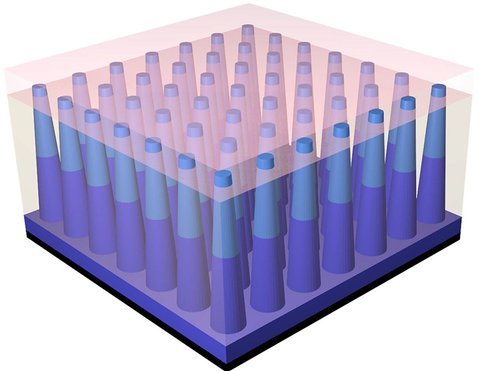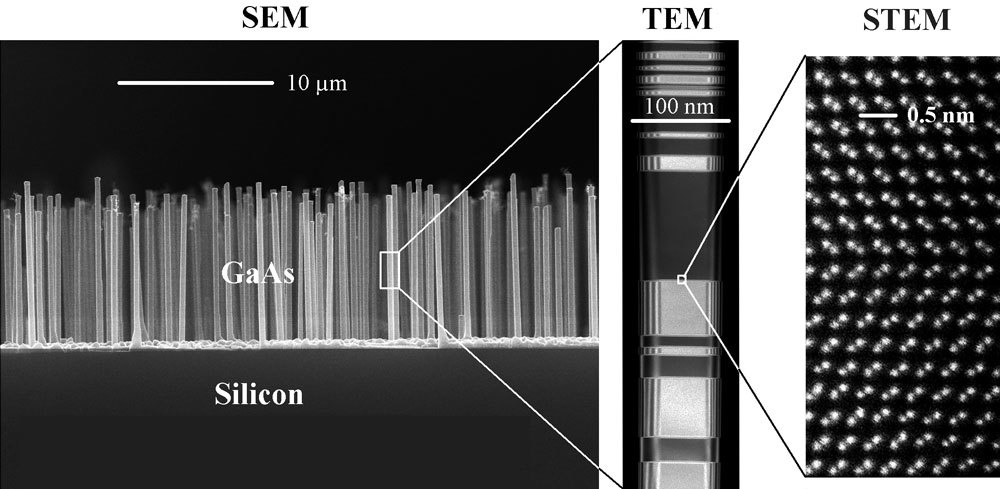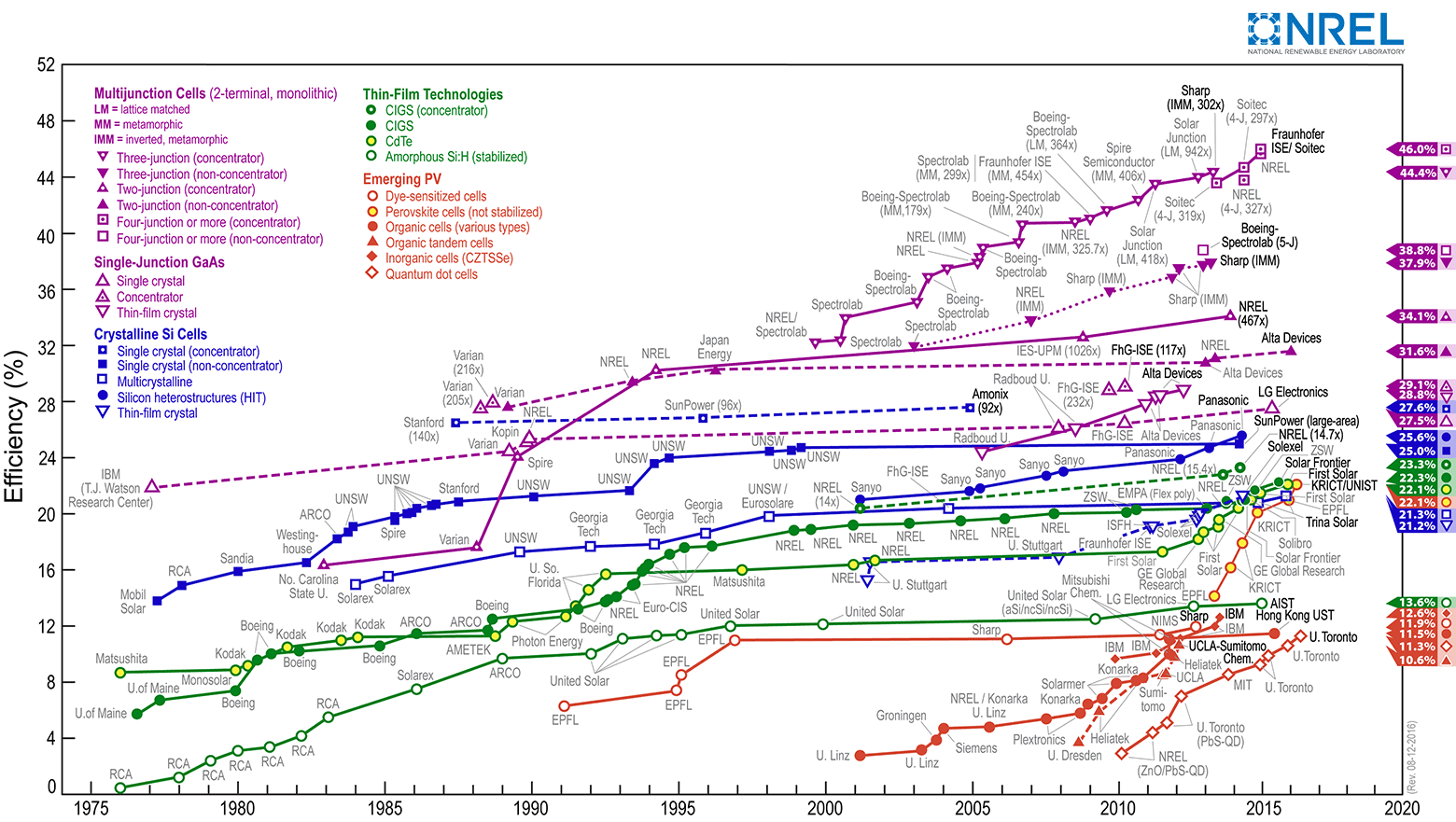The efficiency of photovoltaic cells with nanowires increased to 17.8%

The schematic structure of the nanowire photocell
Researchers from the Technical University of Eindhoven (Netherlands) set a new record for the efficiency of photovoltaic cells with nanowires: 17.8%. This is a relatively new type of solar cell that was invented less than a decade ago. In such a short time, he was able to approach in efficiency the traditional types of single-layer photovoltaic cells.
Such rapid progress indicates that nanowire photovoltaic cells are a very promising technology. About this inventors talked from the very beginning. “Focusing” photons through the nanowires looks so tempting that you can dream of a drastic increase in efficiency.

Photocell with standing nanofibres of gallium arsenide. Photo: Nanotechnology Center of the Niels Bohr Institute (Denmark)
')
Unlike other types of photovoltaic cells, nanowire photovoltaic cells consist not of solid dense layers, but of a lattice of vertical fibers with a thickness of about 200 nanometers each.
In 2013, Peter Krogsstrup from the Nanotechnology Center at the Niels Bohr Institute (Denmark) together with scientists from the Federal Polytechnic School of Lausanne (Switzerland) constructed a prototype photocell ( pdf ) with an area of 1 mm 2 with standing nanofibres of gallium arsenide. In normal sunlight, a current corresponding to 24.6 mA per square centimeter of surface was removed from the photocell. In fact, standing nanofibres concentrated light from the area, 15 times larger than their total cross sections.
Such phenomenal indicators are explained by the resonance of waves of visible light, the length of which is less than the cross section of the standing fiber. Colliding with standing fibers, neighboring waves enter into resonance. The grating of standing fibers like a vacuum cleaner “sucks” in itself the surrounding light.
Note from the distinguished KhKnstn : The current removed from the photocell depends on the generation of charge carriers, which are excited when they absorb photons of light. Normal sunlight is a standard value with a known spectral density of photons with a total power of 100 mW / cm². For indium phosphide used in the 2016 study, the maximum current can be 34.5 mA / cm².
In general, there is still need to understand the logical trick with the concentration of light is 15 times more. It is a matter of arranging the nanosheels relative to each other and the ratio of the surface area that the nanostage occupies in relation to the unoccupied space. But this does not play any role, because usually the received energy is normalized to the area of the illuminated surface.
If we accept “cheating” with resonance, then nanofibres generally must overcome the Shockley-Quisser fundamental limit , which is 33.7% for a cell with one pn junction, 42% for a two-layer cell, 49% for a three-layer cell and 68% for a hypothetical cell with an infinite number of layers.
Record efficiency of different types of photovoltaic cells, 1976-2016

Soon after the first prototypes, other scientists began experimenting with real nanowire photocells. The efficiency of such elements began to grow rapidly.
Now, a group of researchers from the Technical University of Eindhoven, for the first time, demonstrated in real conditions the efficiency of a nanowire photocell 17.8%. According to researchers, this is not the limit. The authors of the scientific work Dick van Dam and Yingchao Cui are confident that the record will fall quickly. They predict that the 20% efficiency limit will be overcome within two years. The increase in efficiency is associated with the theoretical work of physicists who calculated the more efficient shape and diameter of nanofibers, as well as their mutual arrangement. Their achievement is precisely in the optimization of the “forest” of nanofibers, which made it possible to reduce the number of defects.
The previous record achievement for this type of photovoltaic cells was 15.3%. This result was shown by researchers from the University of Lund (Sweden). It is believed that the theoretical limit of efficiency for a nanowire photocell is 46%, that is, much higher than the Shockley-Quisser fundamental limit for traditional elements where the resonance effect is not involved.
Scientists emphasize that another advantage of nanowire photovoltaic cells is their theoretical cheapness in mass production, even in comparison with the manufacturing technology of traditional photocell, which has been rolled in for decades. An important advantage is that it takes five times less material to make new cells. This is not only cheaper and energy efficient. The less material - the less defects and defective batches. At least theoretically.
In order for nanowire photovoltaic cells to become commercially attractive, they must be matched with conventional elements in cost and efficiency. To do this, you need to bring the efficiency to at least 25% and improve the technical process of their manufacture. A further reduction in price can be achieved by switching from the use of rare metals, such as gallium arsenide and indium phosphide, to more common silicon. Another way to reduce the cost - the invention of the technical process for the production of photovoltaic cells without using a thick substrate.
For his work on the calculation and fabrication of nanowire photovoltaic cells with a resorption efficiency, Dick van Dam on October 17, 2016, received a PhD from Eindhoven Technical University. Unfortunately, his doctoral thesis was not published in the public domain. Until an independent review and publication of a scientific article in an official journal, the author refrains from disclosing the technical details of the invention.
In a university press release , it is noted that Dr. van Dam is known as the winner of the season of the television quiz Met het Mes op Tafel , which combines poker and erudition.
Source: https://habr.com/ru/post/398483/
All Articles